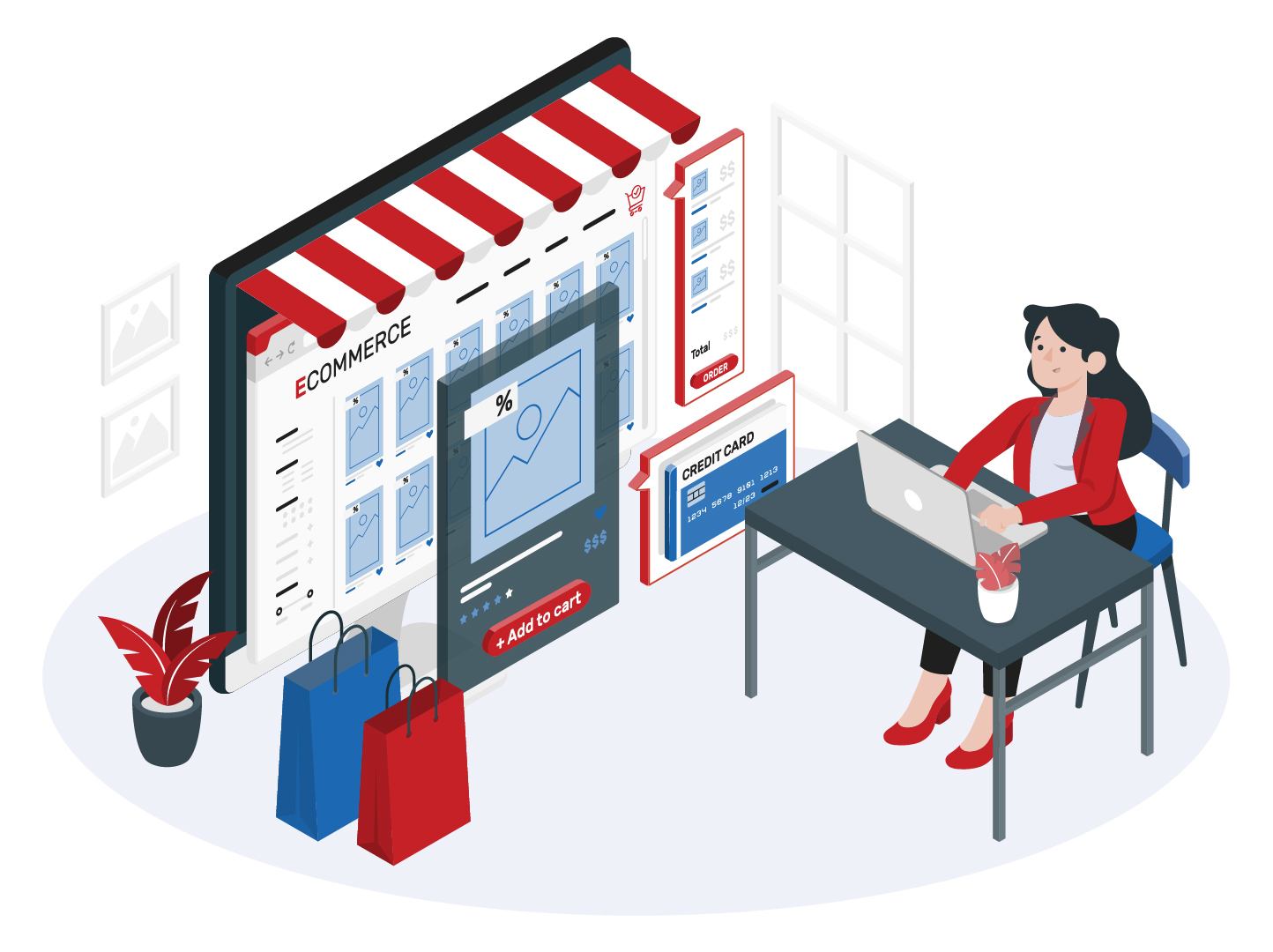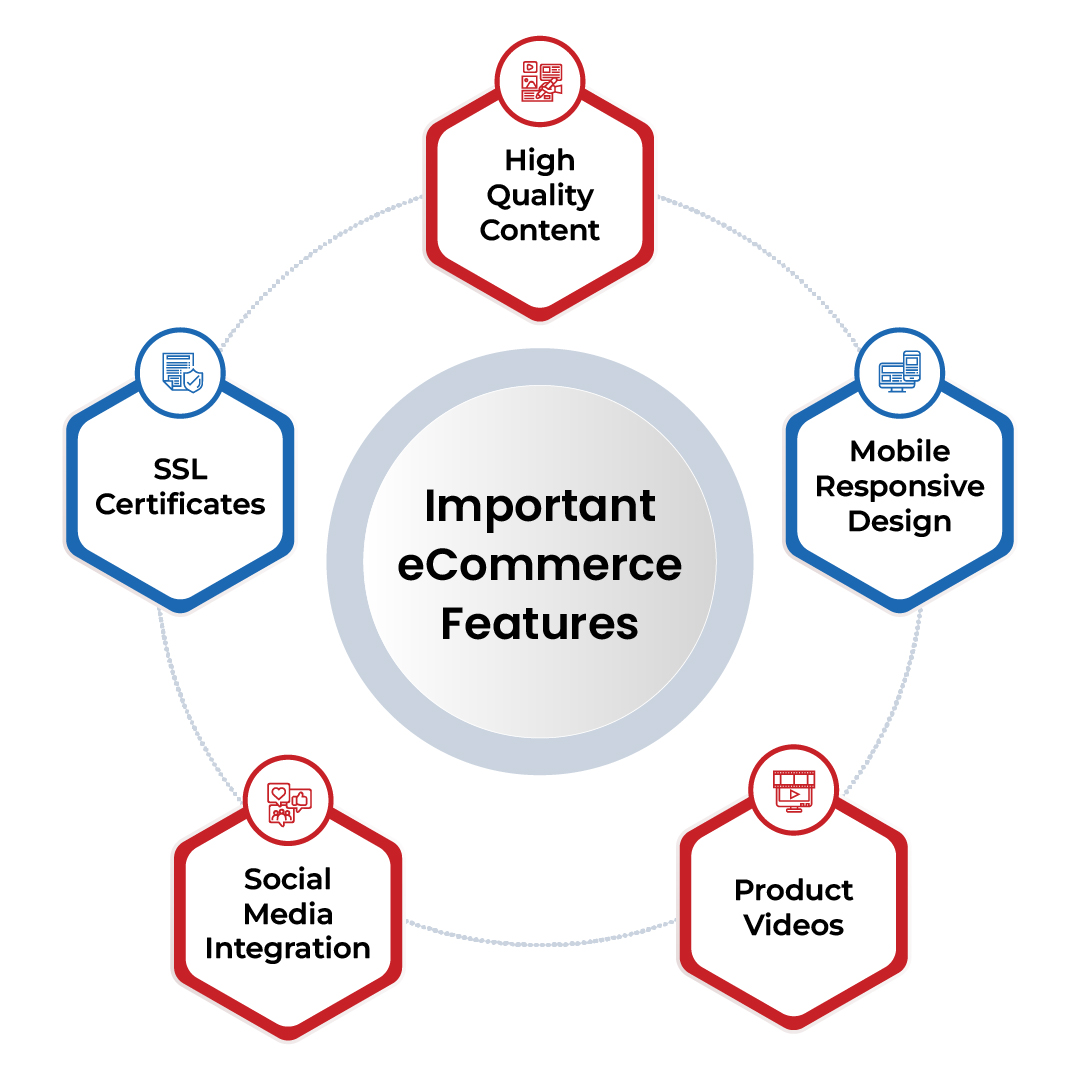
Here’s WHY You Probably Need An eCommerce Business Website — Plus 8 Steps To Get Started!
Julian Wallis
15 min read

Have you been thinking of building an interactive eCommerce website for your business? Provided your business model is suited for eCommerce, it can be a solid way to assert your online presence, boost sales, and increase customer engagement — but where do you start?
Building an eCommerce business website can boost a company in many ways, which is one of the reasons why eCommerce has seen the level of adoption growth that it has in recent years. Developing an eCommerce website may sound easy, but many factors need to be considered to succeed.
In this article, we take a look at what business models eCommerce is best for, how you can develop an eCommerce website for your business and the essential things you need to cover to decide whether to use a ready-made template or a custom-built website.
What is an eCommerce Website?
Where do you usually buy electronics or brand-new gadgets? Or even trendy fashion wear for yourself? Most likely, it’s from Amazon, eBay, or other similar eCommerce website brands.
eCommerce is derived from combining “electronic” and “commerce.” In essence, it simply means conducting business over the internet through electronic commerce transactions involving a buyer and a seller.
eCommerce sites allow you to introduce your business to the world and transact with anyone on the internet, even globally, if you wish. Whilst developing an eCommerce website sounds easy, you must consider multiple factors and utilise the right resources to achieve the coveted success!

To develop an interactive eCommerce website, you’ll need to have a few things in place:
- A domain name that customers will remember
- An attractive and engaging design for your site
- User-friendly website content that accurately reflects your business’s products or services
- The ability to take and process online orders from customers
Creating an eCommerce site is all about following set principles and rules after understanding what goes into the development process. Let’s take a look at precisely what this means and how to get started with developing an eCommerce site.
The Need For An eCommerce Website
People love to shop online. If you run a business, you know it’s an incredible opportunity for growth, provided that your business and what you offer is suited to eCommerce.
For example, a local suburban bakery that is well known for the fresh bread it bakes isn’t going to realise any benefit from selling it online to someone on the other side of the world… Hey, it won’t be fresh anymore, right?
Nor is a good barber going to be able to sell and deliver haircuts online but a manufacturer of a unique brand of workout apparel such as Gymshark or a seller of digital audiobooks such as Audible is certainly able to leverage eCommerce to sell to customers all around the world!
An eCommerce website can help your business grow by offering you the opportunity to reach a larger audience of potential customers who already use eCommerce sites to purchase everything from clothes to books to electronics and more!
There are many reasons to develop an eCommerce business, but having one will also help strengthen your brand on the web. It lets more people discover and engage with it and provides an opportunity for you to nurture them into becoming loyal customers. However, before starting this process, you need to understand what your business needs to create an online store adapted to it.
To get the most from your eCommerce business, you must ensure your objectives and strategy are solid. Developing an interactive eCommerce website for your business by using features that are of no use to your target market is a waste of time and money. Understanding your ‘Buyer Persona’ and the journey that a prospect takes to becoming a buying customer and building your eCommerce website in alignment with them is a MUST if you want to increase conversions and generate more online sales for your business.
Moreover, eCommerce websites are dynamic, which means they have more functionality than static websites to help deliver a great user experience. Users should be able to access information quickly, have different payment options available, and experience reliable customer service.
What Features Should An eCommerce Website Have?
Suppose you do want to develop an online store for your business; you will want one that offers these five essential following features;
👉 High-Quality Content
Having a lot of information about your products will make it easier for customers to learn about and select what will best fit or solution to their needs as educated buyers. Include detailed product descriptions with multiple photos and illustrations to help them understand and see what they are purchasing. You will also rank better in search results when potential buyers are looking for specific items that you offer.
You can include SEO keywords in your product descriptions and other relevant information to increase the chances of appearing higher in search engine rankings, although only do this in a way that makes sense and adds value to the website visitor; otherwise, it will be obvious you are keyword stuffing which Google will penalise you for. It is a good idea to add visual content such as related informative blog posts or infographics that will help you create a more substantial online presence and ultimately encourage more digital sales by increasing conversion rates.
👉 Mobile-Responsive Design
Most people now use mobile devices to browse the internet. If your website isn’t optimised for mobile, your users will quickly become frustrated if they find it difficult to make purchases because they can’t see everything clearly; scrolling through menus and categories may be problematic on mobile screens.
However, if they can easily make purchases from their smartphones or tablets, your conversion rates will increase, and your website will sell more products. What’s more, Google penalises sites that aren’t mobile-friendly, so having a well-designed, responsive, and highly optimised eCommerce site that provides your website visitors with the same great experience no matter what device they are on is worth it.
👉 Product Videos
You can use videos to deliver a more realistic perspective of your products, increase their value, and improve conversions. You don’t have to invest in expensive high-end video equipment or hire a professional video producer to get these videos either; most smartphone cameras of today are more than adequate when used correctly. Explain the benefits of a product through an informative video as well as the text description of the product page (for SEO purposes) so users can also see how it works before they buy it.

Product videos are also great for an eCommerce store that sells clothing as they can be used to inspire customers to try different styles and match items better. Many people are highly visual learners and would rather watch videos than reading text; therefore, visual content will increase interest in your products and boost conversions online.
👉 Social Media Integration
Social media is a tool that eCommerce businesses can harness to improve their sales. Develop your website to integrate social media platforms like Facebook, Twitter, Instagram, or Pinterest so users can quickly share products they love with others. This will increase the traffic on your site and help you rank higher in search engines because Google puts more weight on websites where people are engaged but also shared content helps improve engagement when you have strong communities engaging with your brand.
Developing a steady audience for your eCommerce business takes time if relying solely on organic traffic. If you want to promote it online, you need to take advantage of tools like social media marketing and influencers which will help you expand your audience faster.
👉 SSL Certificates
Trust is one of the essential principles for eCommerce transactions since customers often make purchases on the internet without meeting anyone. That’s why you should make sure your website is secured by a valid SSL certificate, which assures customers that they are entering a safe site when paying for products or services using debit or credit cards. Develop an eCommerce website with SSL certificates to show potential customers that you care about their security and ensure them that they can trust you with their details.
How to Develop an Interactive eCommerce Website?
So what are the steps you need to follow to develop an eCommerce website? Below is a step-by-step procedure that will help you get started with developing and implementing an interactive eCommerce website.
Note that we’re assuming that you’ve already figured out what you want to sell or offer by this point in time. If you’re still thinking about picking the best product or service that’s right for you, you need to do some research to identify possible gaps and opportunities in the marketplace you can service.
If you are ready with your product or service, then follow the steps below:
#1 – Purchase a Domain Name
Before anything else, you need to buy a domain name — the identifying name and brand of your website that customers will remember. A domain name is what people type in their browsers to access a website.
The domain name you choose should be short and contain keywords. It shouldn’t have any numbers or hyphens. If you need more help, check out our blog post on choosing a domain name that provides you with all the dos and don’ts.
#2 – Choose Your eCommerce Platform
After choosing your domain name, it’s time to activate the core part of the development process. You must select an eCommerce platform CMS (Content Management System) that fits your needs.
Whether to choose Magneto, Shopify, or WooCommerce depends on the functionality and features of your eCommerce website and whether it’s B2B or B2C. Which platform meets your business requirements the most? Do some research before deciding on one website builder.
#3 – Find a Team of Developers or An Experienced Agency
Now that you’ve purchased the domain name and chosen an eCommerce platform, it’s time to prepare a plan (here is how we do this part) and get things rolling. Depending on how complex your website project is, it can be a good idea to engage the help of a website development professional for this critical step. If you need more resources on things you should consider before beginning the designing and coding process, check this article we put together on what you must consider before starting any website build.
Building your own website takes time and effort, and you can likely spend that time more productively elsewhere. Unless you’re an expert on UI/UX design, front-end/back-end coding, data warehousing, etc., it won’t be an effective use of your time and probably will end up costing you a lot more than you thought.
In most website project cases, we recommend you consider utilising the services of an experienced agency that specialises in eCommerce development. This way, you get their experience, knowledge, and expertise on your side while simultaneously having the time to focus on other factors to develop your business.
In rare cases, you might as well choose to use a pre-existing option, such as a website builder, and work with a team of freelance developers. This option, however, comes with a steeper learning curve and might end up costing you more.
#4 – Get a Mobile-Responsive Theme with Customisation
More and more people use mobile phone applications to browse eCommerce sites today than ever before. so your platform must optimise your eCommerce site for an excellent mobile experience.
A highly optimised and mobile-responsive theme is non-negotiable if you want your site to sell for you. Also, seek ways to enhance customer experience through mobile technology such as geolocation functionality which helps customers quickly get directions to your store or find the nearest branch to their own location.
#5 – Select a Payment Gateway
Whether you choose a website builder or custom development, you will need a payment gateway for your eCommerce website. You need an online payment gateway provider to accept online payments — such as credit/debit cards or online wallets.
Whilst you can, it doesn’t mean you should and instead of building your own payment gateway, we recommend choosing a provider that’s easy to integrate with your eCommerce platform. These providers charge you a small fee for using their product (usually 1-2% of transaction fees), but it is often the best solution when considering security and ease of implementation.
Based on our experience and expertise, we have advised many of our clients to use Stripe, which we believe to be the best payment gateway available at this time. To learn more about Stripe and how you can integrate it with your business, read our write-up on Stripe.
#6 – Add Product Details to Your Website
If you have nothing to sell, it makes no sense to create an eCommerce website. That’s why the next step is to add products or services you want to sell and their details to your website.
Make sure to add the products’ names, prices, and descriptions — along with their high-quality images and videos. In today’s age of YouTube, you must post product-related videos that customers can watch. Having customers’ reviews is also a great way to ensure a product’s effectiveness or useability.
Besides, don’t forget to include some short- and long-form content in the blog section to drive more traffic to your website. Writing honest and informative content will perform well in SEO and attract more visitors.
#7 – Use Google Analytics to Track Website Traffic
To track all the visitors coming to your eCommerce website, you can use Google Analytics. That way, you’ll know which pages customers frequently visit and how long they spend on your website before making a buying decision.
You can also keep track of the bounce rates — customers leaving the web page as soon as they visit — and analyse what’s not working. Analytics is also a great tool to revamp the pages or products performing poorly and boost those doing really well.
#8 – Launch Your eCommerce Website
Once you’ve finished these steps, you can complete your website’s final polishing touches and testing. Finally, launch your website — then search for any existing issues that may have been missed and then search again! Ensure that links to product listings, shopping carts, and checkout pages all are working as they should be.
If you are working with a team of developers — or a software agency — they will most likely take care of the eCommerce website’s launch and post-launch quality assurance. This will inevitably make the testing process manageable and efficient. Should you use a website builder, make sure to do some quality assurance testing side by side.
Things To Consider When Building an eCommerce Website
An interactive eCommerce website improves your user experience, encourages them to stay longer on your website, make and repeat purchases, and leave you great reviews. You need to ensure a few things are checked off for your eCommerce website to achieve that.
✔️ Easy Navigation
Ensure that your website is easy to navigate to your product or service category pages. Customers need to know easily where to look for the products or services they are searching for.
✔️ Pop-up Buttons
You should also display customised offers for new and recurring customers when they open your site. It could redirect the interested visitors to a request for purchase.
✔️ Advanced Search Bar
Many visitors are happy to browse a website and find items they like, but some know exactly what they’re looking for and want it NOW! A search bar gives them a way to get directly to the page they need and is, therefore, a feature every eCommerce site should have.
✔️ Customer Support
Adding a chat box or contact details is a great way to help your customers address their enquiries. It also helps to enhance your site’s credibility and have a real-time conversation with your customers.
✔️ Image, Images, Images
We cannot stress enough how displaying high-quality images with the added zoom-in feature or video reviews from trusted sources is another effective way to boost website engagement — your customers will want to view products, watch videos, and read reviews before considering buying.
✔️ Your Unique Selling Point (USP)
Every eCommerce website has its own unique selling point or USP. Make sure to display your USP that reflects your added services or trusted certifications. For instance: 24-hour shipping, free delivery, 100% warranty, etc., urge customers to purchase more products.
✔️ Newsletter Subscription
It is imperative to get your customers’ email addresses into your database so that you can later send offers and discounts to them directly. Unlike other digital marketing strategies, email marketing establishes one-to-one contact with prospects and customers alike and is low-cost.
Final Thoughts
While the technology of today’s world has made access to building an online eCommerce store more straightforward than ever before, there are still some things to be checked off and ensure you get them right if you want the site to be a success — especially when you have a great product or service to sell, some determination, and the willingness to learn.
So what are you waiting for? Start building your eCommerce website today and get selling online. If you need any help along the way, our team is more than happy to assist.
In any case, thanks for sticking with us until the end — we know building an online store can seem daunting, but it can be made a lot easier when you break it down into simple steps! In fact, we would love to hear from you about your experiences with eCommerce — good or bad… reach out to us here, anytime.
Topics
Published On
January 31, 2022

